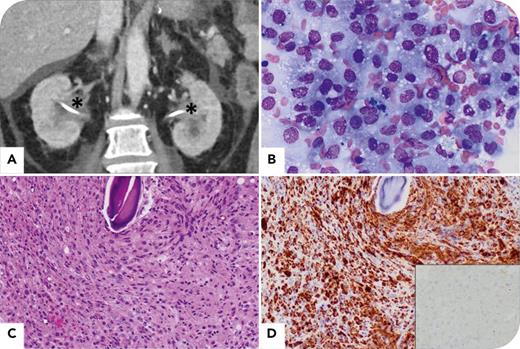A 58-year-old man with nonsecretory multiple myeloma undergoing chemotherapy presented to urgent care with hypokalemia and pancytopenia (hemoglobin 7.9 g/dL, absolute neutrophil count 0.01 × 10³/μL, platelets 14 × 10³/μL). A computed tomography scan with iodinated contrast showed infiltrative thickening of both collecting systems (asterisks, panel A), known as the “hairy kidney” sign, resulting in bilateral obstruction and hydronephrosis, which necessitated ureteral stenting. Bone marrow aspirate smears depicted sheets of histiocytes with foamy cytoplasm and hemosiderin, without Tuton giant cells (panel B; original magnification ×200, Wright-Giemsa stain). Core biopsy revealed diffuse infiltration of foamy histiocytes (panel C; original magnification ×200, hematoxylin-eosin), which expressed CD68 (panel D; original magnification ×200), CD163, factor XIII, cyclin D1, and BRAF V600E (subset), while being negative for CD1a (panel D, inset; original magnification ×200) and S100. Next-generation sequencing identified NRAS p.Q61R and BRAF p.V600E mutations. No evidence of minimal residual plasma cell neoplasm was detected by both flow cytometry and ClonoSeq. A diagnosis of Erdheim-Chester disease (ECD) was made.
ECD is characterized by the proliferation of neoplastic foamy histiocytes driven by activating mutations in the RAS-RAF-MEK-ERK pathway, which can benefit from treatment with BRAF and/or MEK inhibitors. Although ECD commonly coexists with myeloid neoplasms, its occurrence in patients with multiple myeloma has not been reported until now to the best of our knowledge.
For additional images, visit the ASH Image Bank, a reference and teaching tool that is continually updated with new atlas and case study images. For more information, visit https://imagebank.hematology.org.


